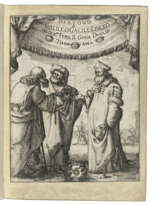[GALILEO GALILEI (1564-1642) and Girolamo SPINELLI (c.1580-1647)]
09.07.2025 10:30UTC +00:00
Classic
Verkauft
1129000GBP £ 1 129 000
| Auctioneer | CHRISTIE'S |
|---|---|
| Veranstaltungsort | Vereinigtes Königreich, London |
| Aufgeld | see on Website% |
Archiv
Die Auktion ist abgeschlossen. Es können keine Gebote mehr abgegeben werden.

ID 1450385
Los 87 | [GALILEO GALILEI (1564-1642) and Girolamo SPINELLI (c.1580-1647)]
Schätzwert
£ 500 000 – 700 000
Cecco di Ronchitti da Bruzene. Dialogo in perpuosito de la stella nuova. Padua: Pietro Paulo Tozzi, 1605.
The exceptionally rare first edition of Galileo’s first published book. No other copy is recorded on the market in over a century; no other copy is known in private hands; only 7 other complete copies are known, all in institutions.
The sudden appearance, on 9th October 1604, of what would come to be known as Kepler’s Supernova presented a major challenge to the then-prevailing belief in the unchangeability of the heavens and helped to usher in a new era of astronomical understanding. Systematically observed by Johannes Kepler, it reached a peak brightness that surpassed even Jupiter in the night sky and remained visible to the naked eye for about 18 months. Kepler’s observations formed the basis of his important 1606 work De Stella Nova, a landmark in the history of astronomy and the study of stellar evolution. His work was preceded, however, by a dialogue published in 1605 under the pseudonym Cecco di Ronchitti, which presents a conversation between two peasants in a rustic Paduan dialect about the appearance of the 1604 supernova. The Dialogo in perpuosito de la stella nuova is widely understood to be the first published work of the ‘father of modern science’, Galileo Galilei, whose revolutionary contributions to physics, astronomy, and the scientific method fundamentally transformed how humanity understands the celestial sphere.
A witty rebuke to the ‘natural philosophers who studied Aristotle but had little time to look up at the heavens' (Shea), the ‘principal concern’ of the Dialogo in perpuosito de la stella nuova ‘was to promote measurement as the only secure criterion in scientific research' (Lewis). It was in fact intended as a direct response to a pamphlet by Aristotelian philosopher Cesara Cremonini (Discorso intorno alla nuova stella), published in Padua at the beginning of 1605 under the pseudonym Antonio Lorenzini. Cremonini interpreted the supernova as a terrestrial phenomenon, believing that ‘if a single star were added to the heavens, they would cease to revolve’ (Shea). Galileo takes a different view, suggesting that the appearance of the nova urges a rejection of the Aristotelian belief in the immutability of the skies – a belief that had held sway for nearly two millennia and been a fundamental principle of astronomy prior to the scientific revolution.
The dialogue unfolds between two peasant characters, Matteo and Natale, who debate Cremonini’s ideas and offer a systematic critique of his contradictions and distortions. This format, and the pseudonymous nature of the publication, allowed Galileo to indirectly confront Aristotelian views without openly engaging in controversy himself. The use of a vernacular dialogue form allowed him to present his ideas in an approachable and engaging manner, making complex astronomical ideas accessible to a broader audience and anticipating the style he would later employ in his Dialogo sopra i due massimi sistemi del mondo (1632). A second edition published in Verona later in 1605 softened some criticisms of Aristotle and removed dangerous Copernican allusions to the Earth's rotation, reflecting the cautious political climate surrounding scientific ideas at the time.
Despite the work’s anonymity, most scholars agree that Galileo was the author or co-author alongside his student Girolamo Spinelli. The Dialogo in perpuosito de la stella nuova was included in Antonio Favaro’s National Edition of Galileo’s works in 1891 and, when Stillman Drake translated the work into English in 1976, he provided various arguments in favour of Galileo’s role in the publication. In 2024, Professor Alessandro De Angelis of the University of Padua reinforced the part-attribution to Galileo in his monograph Galileo and the 1604 Supernova, while his colleague at Padua, associate professor Giulio Peruzzi, declares ‘it is nowadays ascertained that the text was written jointly by Galileo and Girolamo Spinelli, a young Benedictine monk of Galileo’s circle.’
The Dialogo in perpuosito de la stella nuova is a testament to Galileo's innovative approach to science communication and his willingness to challenge established doctrines. It marks an important step in Galileo's break with traditional astronomical and philosophical views, paving the way for his later, more comprehensive works on the nature of the universe. Indeed, as a dialogue contributing to the debate about the new scientific understanding of the cosmos which aims for a popular rather than erudite communication of scientific ideas, it bears several of the hallmarks of Galileo’s later works. Of the 11 examples traced in institutions worldwide, 8 remain in Italy (of which 4 are incomplete), 2 are in the UK (Oxford and Cambridge), and 1 is in Germany (Berlin State Library). Carli and Favaro, 18.
Quarto (200 x 145mm). Collation: A-D⁴ E². Title within type ornament border and with pastoral woodcut vignette, woodcut and type ornament head-and tailpieces, some deckle edges preserved (faint crease to corner of title, small chip to corner of blank margin in B1, a few minor stains [heavier to D1] and light finger-soiling). 19th-century Italian paste paper-covered boards, spine ruled in gilt (lightly rubbed and faded, tiny trace of old label to upper board). Provenance: references to Lorenzini in the printed shoulder notes inked out probably at an early date – inscription dated April 1841 with the initials ?‘G.A’ on front pastedown – Guglielmo Libri (1803-1869, celebrated polymath, bibliographer, and thief; inscription in French on front pastedown) – Giacomo Maria Manzoni (1816-1889, Italian bibliographer and politician; ownership inscription including identification of Libri’s hand on front pastedown) – bookseller’s pencil note to rear pastedown.
Literature:
DE ANGELIS, A. Galileo and the 1604 Supernova. Cham : Springer International Publishing , 2024.
DONAHUE, W. H. Essay Review: ‘Works Ascribed to Galileo, Galileo against the Philosophers in his “Dialogue of Cecco di Ronchitti” (1605) and “Considerations of Alimberto Mauri”(1606)’, in: Journal for the History of Astronomy, 10(1), 44-47, 1979.
DRAKE, Stillman. Galileo Against the Philosophers in His Dialogue of Cecco Di Ronchitti (1605) and Considerations of Alimberto Mauri (1606). Los Angeles: Zeitlin & Ver Brugge, 1976
PERUZZI, Giulio. ‘A New Physics to Support the Copernican System: Gleanings from Galileo's Works’, in: Proceedings of the International Astronomical Union. 6 (S269): 20–26, 2010.
SHEA, W. ‘Galileo and the Supernova of 1604’, in: 1604-2004: Supernovae as Cosmological Lighthouses, ASP Conference Series, Vol. 342, Proceedings of the conference held 15-19 June, 2004 in Padua, Italy. Edited by M. Turatto, S. Benetti, L. Zampieri, and W. Shea. San Francisco: Astronomical Society of the Pacific, 2005.
| Künstler: | Galileo Galilei (1564 - 1642) |
|---|---|
| Herkunftsort: | Italien, Europa |
| Kategorie des Auktionshauses: | Medizin und Wissenschaft, Bücher und Handschriften, Gedruckte Bücher |
| Künstler: | Galileo Galilei (1564 - 1642) |
|---|---|
| Herkunftsort: | Italien, Europa |
| Kategorie des Auktionshauses: | Medizin und Wissenschaft, Bücher und Handschriften, Gedruckte Bücher |
| Adresse der Versteigerung |
CHRISTIE'S 8 King Street, St. James's SW1Y 6QT London Vereinigtes Königreich | |
|---|---|---|
| Vorschau |
| |
| Telefon | +44 (0)20 7839 9060 | |
| Aufgeld | see on Website | |
| Nutzungsbedingungen | Nutzungsbedingungen |
![[GALILEO GALILEI (1564-1642) and Girolamo SPINELLI (c.1580-1647)] - Foto 1 [GALILEO GALILEI (1564-1642) and Girolamo SPINELLI (c.1580-1647)] - Foto 1](/assets/image/picture_4734998/b5ed1/b78ba02793ea9f7c89bc2421c803edfc1752012000jpg__fix_555_460.jpeg)
![[GALILEO GALILEI (1564-1642) and Girolamo SPINELLI (c.1580-1647)] - Foto 2 [GALILEO GALILEI (1564-1642) and Girolamo SPINELLI (c.1580-1647)] - Foto 2](/assets/image/picture_4734999/29d64/f90e4e1f72b285c0aaa05956054bbb1e1752012000jpg__fix_555_460.jpeg)
![[GALILEO GALILEI (1564-1642) and Girolamo SPINELLI (c.1580-1647)] - Foto 3 [GALILEO GALILEI (1564-1642) and Girolamo SPINELLI (c.1580-1647)] - Foto 3](/assets/image/picture_4735003/7ab2d/e0bd7d5549463fdd87968ab805cd04eb1752012000jpg__fix_555_460.jpeg)








![[GALILEO GALILEI (1564-1642) and Girolamo SPINELLI (c.1580-1647)] - Foto 1 [GALILEO GALILEI (1564-1642) and Girolamo SPINELLI (c.1580-1647)] - Foto 1](/cache/lot/1450385/b78ba02793ea9f7c89bc2421c803edfc_1752012000-80x80_center_50.jpg)
